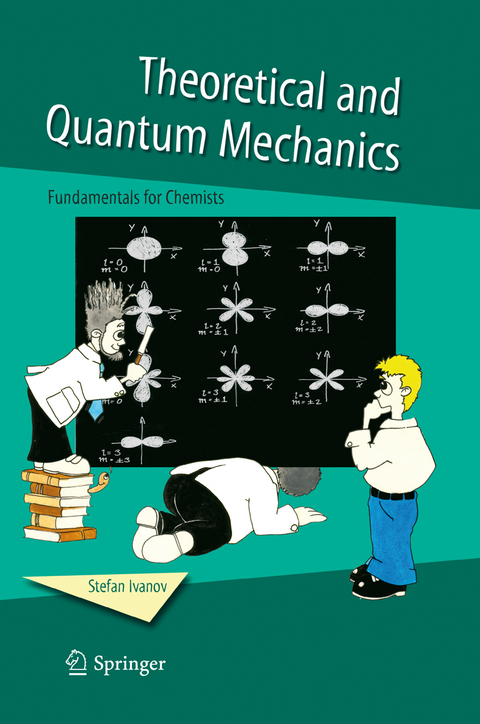
Theoretical and Quantum Mechanics
Fundamentals for Chemists
Seiten
2005
Springer-Verlag New York Inc.
978-1-4020-3365-0 (ISBN)
Springer-Verlag New York Inc.
978-1-4020-3365-0 (ISBN)
I have included those parts of quantum mechanics which are of greatest fundamental interest and utility, and have developed those parts of classical mechanics which relate to and illuminate them. I present in one course the basics of theoretical mechanics and quantum mechanics, to emphasise the continuity between them;
This book has emerged from an undergraduate course as well as a graduate one, which I have taught for a number of years. Recently, many universities have experimented by bringing quantum theory forward in the curriculum and we follow their example. This book is intended to serve as an introduction to theoretical mechanics and quantum mechanics for chemists. I have included those parts of quantum mechanics which are of greatest fundamental interest and utility, and have developed those parts of classical mechanics which relate to and illuminate them. I try to give a comprehensive treatment wherever possible. The book would acquaint chemists with the quantum structure of the basic object of chemistry, the atom. My intention is to bridge the gap between classical physics, general and inorganic chemistry, and quantum mechanics. For these reasons: 1. I present in one course the basics of theoretical mechanics and quantum mechanics, to emphasise the continuity between them; 2. I have chosen the topics of theoretical mechanics based upon two criteria: a) usefulness for chemical problems: two-body problem; rotational motion of a charged particles (free and in an atom); interaction of a magnetic field with a magnetic dipole; details of small oscillations and oscillations of molecules; b) the need for transition from classical to quantum mechanics: basics of Lagrangian mechanics; basics of Hamiltonian mechanics; 3. I give detailed explanation of an application of the quantum method to simple systems: one-dimensional potential, harmonic oscillator, hydrogen atom, and hydrog- like atoms.
This book has emerged from an undergraduate course as well as a graduate one, which I have taught for a number of years. Recently, many universities have experimented by bringing quantum theory forward in the curriculum and we follow their example. This book is intended to serve as an introduction to theoretical mechanics and quantum mechanics for chemists. I have included those parts of quantum mechanics which are of greatest fundamental interest and utility, and have developed those parts of classical mechanics which relate to and illuminate them. I try to give a comprehensive treatment wherever possible. The book would acquaint chemists with the quantum structure of the basic object of chemistry, the atom. My intention is to bridge the gap between classical physics, general and inorganic chemistry, and quantum mechanics. For these reasons: 1. I present in one course the basics of theoretical mechanics and quantum mechanics, to emphasise the continuity between them; 2. I have chosen the topics of theoretical mechanics based upon two criteria: a) usefulness for chemical problems: two-body problem; rotational motion of a charged particles (free and in an atom); interaction of a magnetic field with a magnetic dipole; details of small oscillations and oscillations of molecules; b) the need for transition from classical to quantum mechanics: basics of Lagrangian mechanics; basics of Hamiltonian mechanics; 3. I give detailed explanation of an application of the quantum method to simple systems: one-dimensional potential, harmonic oscillator, hydrogen atom, and hydrog- like atoms.
Selected Topics of Theoretical Mechanics.- Lagrangian Function and Lagrange’s Equations.- Conservation Laws.- Central Conservative Forces.- Rotating Motion of a Charged Particle.- Small Harmonic Oscillations.- Hamiltonian Mechanics.- Basics of Quantum Mechanics.- The Sources of the Quantum Mechanics.- Old Quantum Mechanics.- The Wave Function.- Operators.- The Schroedinger Equation and Time Dependence of the Observables.- Motion in One-Dimensional Potential.- The Harmonic Quantum Oscillator.- The Two-Body Problem - a Hydrogen Atom and a Diatomic Molecule.- Perturbation Theory and Stark Effect.- Spin.- Interaction of an Electron in an Atom with Magnetic Field.- The Helium Atom.- Periodic Table.
| Erscheint lt. Verlag | 15.11.2005 |
|---|---|
| Zusatzinfo | XXIV, 513 p. |
| Verlagsort | New York, NY |
| Sprache | englisch |
| Maße | 155 x 235 mm |
| Themenwelt | Naturwissenschaften ► Chemie ► Anorganische Chemie |
| Naturwissenschaften ► Chemie ► Physikalische Chemie | |
| Naturwissenschaften ► Physik / Astronomie ► Atom- / Kern- / Molekularphysik | |
| Naturwissenschaften ► Physik / Astronomie ► Hochenergiephysik / Teilchenphysik | |
| Naturwissenschaften ► Physik / Astronomie ► Quantenphysik | |
| Technik ► Maschinenbau | |
| ISBN-10 | 1-4020-3365-6 / 1402033656 |
| ISBN-13 | 978-1-4020-3365-0 / 9781402033650 |
| Zustand | Neuware |
| Haben Sie eine Frage zum Produkt? |
Mehr entdecken
aus dem Bereich
aus dem Bereich
Buch | Hardcover (2024)
Springer Spektrum (Verlag)
64,99 €


